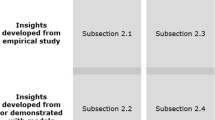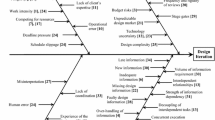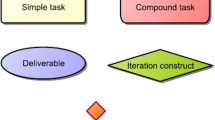Abstract
This paper uses a laboratory experimental setting to make observations about the iteration process in engineering design. Iteration is an important and ubiquitous feature of engineering design. Previous research has constructed prescriptive mathematical models of the iteration process in an attempt to aid the design manager. In this paper, experimental observations are made about design iteration in a group setting, and those observations are compared with the existing models of the iteration process. Some correspondence with existing models is noted, although there are also significant differences. These differences could be used to improve the mathematical models of the iteration process.
Similar content being viewed by others
References
Adler, P.S., Mandelbaum, A., Nguyen, V. and Schwerer, E. From project to process management: an empirically-based framework for analyzing product development time, Manage. Sci. 41(3), 458–484 (1995).
Ahmadi, R.H. and Wang, H. Rationalizing product design development processes, Working Paper, Anderson Graduate School of Management, UCLA, 1994.
AitSahlia, F., Johnson, E. and Will, P. Is concurrent engineering always a sensible proposition? IEEE Trans. Eng. Manage. 42(2), 166–170 (1995).
Alexander, C. Notes on the Synthesis of Form, Harvard University Press, Cambridge, 1964.
Blackburn, J.D. Time-based Competition: the Next Battle-ground in American Manufacturing, Business One Irwin, Homewood, IL, 1991.
Brown, S.L. and Eisenhardt, K.M. Product development: Past research, present findings, and future directions,Academy of Manage. Rev. 20(2),343–378 (1995.
Bucciarelli, L.L. An ethnographic perspective on engineering design, Design Studies 9(3), 159–168 (1988).
Bucciarelli, L.L., Goldschmidt, G. and Whipple, B.C. Delta — A Design Exercise, Massachusetts Institute of Technology, 1991.
Bucciarelli, L.L. Designing Engineers, MIT Press, Cambridge, MA, 1994.
Bucciarelli, L.L. Ethnographic study and simulation of the engineering design process, Proceedings of the International Ergonomics Association: Human Factors in Design for Manufacturability and Process Planning, 1990, pp. 61–66.
Clark, K.B. and Fujimoto, T. Product Development Performance: Strategy, Organization, and Management in the World Auto Industry, Harvard Business School Press, Boston, MA, 1991.
Cross, N. and Clayburn Cross, A. Observations of teamwork and social processes in design, Design Studies 16, 143–170 (1995).
Eppinger, S.D., Nukala, M.V. and Whitney, D.E. Generalized models of design iteration using signal flow graphs, Research in Engineering Design 9(2), 112–123 (1997).
Eppinger, S.D., Whitney, D.E., Smith, R.P. and Gebala, D.A. A model-based method for organizing tasks in product development, Research in Engineering Design 6(1), 1–13 (1994).
Ha, A.Y. and Porteus, E.L. Optimal timing of reviews in concurrent design for manufacturability, Management Sci. 41(9), 1431–1447 (1995).
Kline, S.J. Innovation is not a linear process, Res. Manage. 28(4) 36–45 (1985).
Koushik, M.V. and Mookerjee, V.S. Modeling coordination in software construction: an analytical approach, Infor. Syst. Res. 6(3), 220–254 (1995).
Krippendorff, K. Content Analysis: an Introduction to its Methodology, Sage Publications, Beverly Hills, CA, 1980.
Krishnan, V., Eppinger, S.D. and Whitney, D.E. A model-based framework to overlap product development activities, Manage. Sci. 43(4), 437–451 (1997).
Kuffner, T.A. and Ullman, D.G. The information requests of mechanical design engineers, Design Studies 12(1), 42–50 (1991).
Kusiak, A. and Wang, J. Efficient organizing of design activities, Int. J. Prod. Res. 31(4), 753–769 (1993).
Leong, A. and Smith, R.P. An observational study of design team process: a comparison of student and professional engineers, Ninth International Design Theory and Methodology Conference, Sacramento, CA, 1997.
McGinnis, B.D. and Ullman, D.G. The evolution of commitments in the design of a component, J. Mechanical Design 114, 1–7 (1992).
Nevins, J.L. and Whitney, D.E. Concurrent Design of Products and Processes: a Strategy for the Next Generation in Manufacturing, McGraw-Hill, New York, 1989.
Pahl, G. and Beitz, W. Engineering Design: A Systematic Approach, Springer-Verlag, New York, 1988.
Simon, H.A. The Sciences of the Artificial, MIT Press, Cambridge, MA, 1981.
Smith, P.G. and Reinertsen, D.G. Developing Products in Half the Time, Van Nostrand Reinhold, New York, 1991.
Smith, R.P. and Eppinger, S.D. Identifying controlling features of engineering design iteration, Manage. Sci. 43(3), 276–293 (1997a).
Smith, R.P. and Eppinger, S.D. A predictive model of sequential iteration in engineering design, Manage. Sci. 43(8), 1104–1120 (1997b).
Smith, R.P. and Eppinger, S.D. Characteristics and models of iteration in engineering design, Ninth International Conference on Engineering Design, The Hague, 1993.
Smith, R.P. and Eppinger, S.D. Deciding between sequential and concurrent tasks in engineering design, Concurrent Engineering: Research and Applications 6(1), 15–25 (1998).
Smith, R.P., Eppinger, S.D. and Gopal, A. Testing an engineering design iteration model in an experimental setting, Fourth International Design Theory and Methodology Conference, Scottsdale, NJ, 1992.
Stauffer, L.A., Diteman, M. and Hyde, R. Eliciting and analysing subjective data about engineering design, J. Eng. Design. 2(4), 351–366 (1991).
Steward, D.V. The design structure system: a method for managing the design of complex systems, IEEE Trans. Eng. Manage. EM-28(3), 71–74 (1981).
Tang, J.C. Findings from observational studies of collaborative work, Int. J. Man-Machine Studies 34, 143–160 (1991).
Tang, J.C. and Leifer, L.J. An observational methodology for studying group design activity, Res. Eng. Des. 2, 209–219 (1990).
Ullman, D.G., Dietterich, T.G. and Stauffer, L.A. A model of the mechanical engineering design process based on empirical data, Artificial Intelligence for Engineering Design, Analysis and Manufacturing 2(1), 33–52 (1988).
von Hippel, E. Task partitioning: an innovation process variable, Res. Policy 19, 407–418 (1990).
Whitney, D.E. Designing the design process, Res. Eng. Des. 2, 3–13 (1990).
Author information
Authors and Affiliations
Corresponding author
Rights and permissions
About this article
Cite this article
Smith, R.P., Tjandra, P. Experimental observation of iteration in engineering design. Research in Engineering Design 10, 107–117 (1998). https://doi.org/10.1007/BF01616691
Issue Date:
DOI: https://doi.org/10.1007/BF01616691




